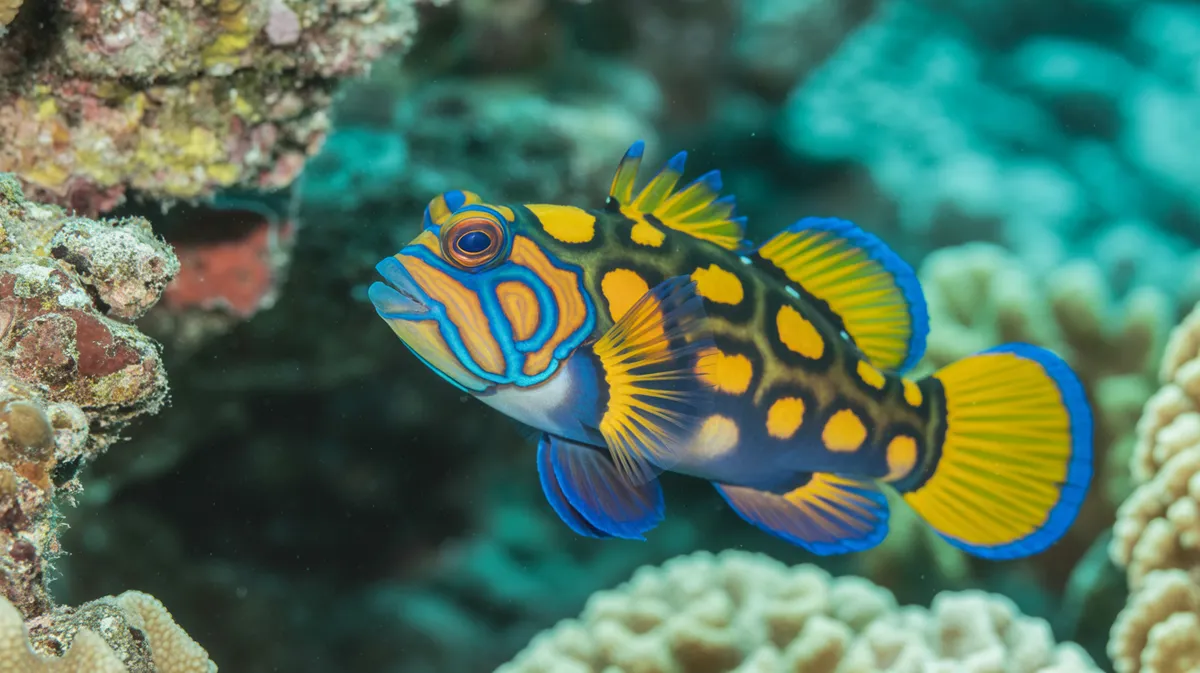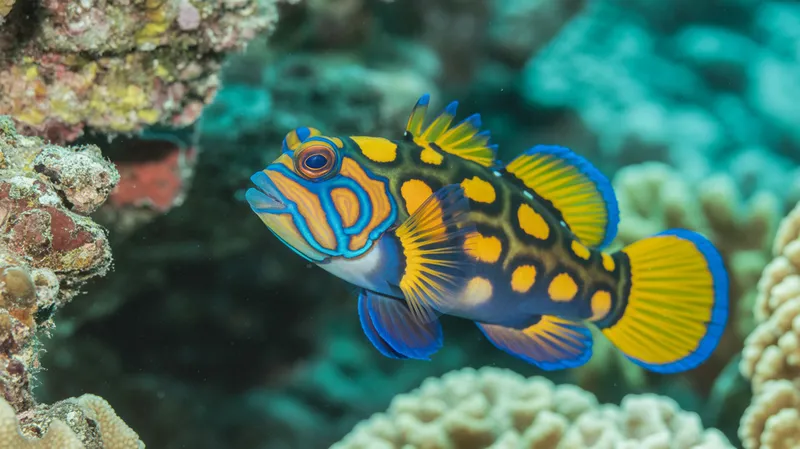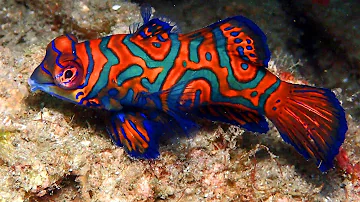
Spotted Mandarinfish
Synchiropus picturatus

Meet the Spotted Mandarinfish
The Spotted Mandarinfish, also known as the Picturesque Dragonet, is a small, vibrantly colored fish native to the Indo-Pacific region. Its body is adorned with striking blue and green patterns, interspersed with orange and yellow spots, making it a favorite among marine aquarium enthusiasts. This species is known for its secretive behavior, often hiding among rocks and coral rubble during the day and becoming more active at dusk. The Spotted Mandarinfish feeds primarily on small invertebrates and is noted for its peaceful temperament.
Classification
Fish
Habitat
Coral reefs and lagoons
Diet
Carnivore
Lifespan
2-4 years
Conservation
Least Concern
Weight
3-7 grams
📖Fascinating Facts
Striking Colors
The Spotted Mandarinfish boasts iridescent blue, green, and orange spots, making it one of the most colorful fish in the ocean.
Toxic Defense
This fish produces a toxic, foul-tasting mucus on its skin, deterring most potential predators.
Courtship Ritual
During breeding, pairs perform synchronized swimming displays, spiraling upwards in the water during their unique courtship dance.
📋Detailed Description
The Spotted Mandarinfish (Synchiropus picturatus) is a small, benthic marine fish, typically reaching lengths of 6–8 cm, with males generally larger than females. Its body is elongated and laterally compressed, covered in a vivid mosaic of iridescent blue, green, orange, and yellow spots and swirls, which are produced by unique cellular structures called cyanophores rather than pigments—a rarity among vertebrates. The head is blunt with large, protruding eyes adapted for acute vision in dim reef environments. The mouth is small and downturned, suited for picking tiny prey from substrate crevices. Fins are ornate, with the dorsal and pelvic fins often extended and used for display or maneuvering among coral rubble. The skin is coated with a thick, mucous layer containing toxins, providing protection against predators and parasites. Spotted Mandarinfish are cryptic and spend much of the day concealed within coral and rubble, emerging primarily at dusk and dawn. They are solitary or form loose aggregations, with males displaying territoriality, especially during breeding periods. Their unique reproductive behavior involves synchronized spawning in the water column, and they exhibit no parental care post-spawning.
💡 Did you know?
Despite their bright colors, Spotted Mandarinfish are rarely seen in the wild due to their reclusive nature and preference for hiding within coral crevices.
🔬Research & Sources
🎭Behavior & Social Structure
Spotted Mandarinfish are primarily crepuscular, foraging most actively at dawn and dusk. They exhibit slow, deliberate movements, 'walking' along the substrate using their pelvic fins. Their feeding strategy is microcarnivorous, targeting small benthic invertebrates such as copepods, amphipods, polychaete worms, and small crustaceans, which they pick from the substrate with rapid mouth movements. They are generally non-aggressive but can display territorial behaviors, particularly males, who may chase or display to rivals during the breeding season. Social interactions are limited outside of mating, with individuals maintaining small home ranges. They rely heavily on camouflage and cryptic behavior to avoid predation, rarely venturing into open water.
👶Reproduction & Life Cycle
Spotted Mandarinfish are oviparous, with a unique courtship ritual that involves elaborate displays by males to attract females. Courtship typically occurs at dusk, when pairs ascend into the water column for external fertilization. The male wraps his body around the female, and both release gametes simultaneously, resulting in a cloud of fertilized eggs that drift away with the current. There is no parental care; eggs are pelagic and hatch within 12–18 hours, depending on water temperature. Larvae are planktonic for several weeks before settling onto the reef as juveniles. Spawning may occur nightly during peak breeding seasons, which often coincide with lunar cycles and warmer months.
🛡️Adaptations & Survival
The Spotted Mandarinfish possesses several notable adaptations: its skin secretes a mucous containing toxins (notably tetrodotoxin-like compounds), deterring most predators and reducing parasite load. The vibrant coloration serves as aposematic (warning) signaling, advertising its unpalatability. Its cryptic behavior and ability to navigate complex reef structures minimize predation risk. The specialized mouth and jaw structure allow precise picking of minute prey from crevices. Additionally, the absence of scales reduces parasite attachment but increases reliance on mucous protection. Their reproductive ascent into the water column reduces egg predation and increases dispersal potential.
📚Research Sources
🎨Cultural Significance
The Spotted Mandarinfish is highly prized in the marine aquarium trade for its striking appearance and peaceful nature, often symbolizing beauty and tranquility in aquarium culture. In some Asian cultures, mandarinfish (including related species) are considered symbols of good fortune and prosperity, though S. picturatus itself has limited direct representation in folklore or traditional uses. Its popularity has led to increased awareness of reef conservation among hobbyists.
🔬Recent Research & Discoveries
Recent research has focused on the unique coloration mechanisms of Synchiropus picturatus, revealing that their blue hues are produced by light-reflecting cyanophores rather than traditional pigments, a rare trait among vertebrates. Studies on their mucous toxins have identified compounds with potential biomedical applications. Ongoing research includes captive breeding protocols to reduce wild collection and investigations into their role in reef microhabitat dynamics. Genetic studies are clarifying phylogenetic relationships within the Callionymidae family.
🎥Wildlife Videos

Wildlife Instincts | The Bizarre Underwater World of Noto Peninsula | Free Documentary Nature
Wildlife Instincts: The Bizarre Underwater World of Noto Peninsula | Wildlife Documentary Watch 'Wildlife Instincts: Mandrills ...
Free Documentary - Nature

Wild Encounters Mandarin Fish © Wild Earth Expeditions
Mandarin Fish “Hummingbird of the sea” - A Wild Earth Expeditions - Wild Encounter For today's Wild Encounters, I have chosen ...
Wild Earth Expeditions

The Hypnotic Beauty of the Mandarin Fish
Dive into the mesmerizing underwater world as we explore the breathtaking beauty of the Mandarin fish . This vibrant creature ...
ANIMAL ANTICS

Mucky Secrets - Part 9 - Mandarinfish & other Dragonets - Lembeh Strait
In this video I study dragonets including the amazing mandarinfish. Dragonets are benthic animals, meaning that they live on the ...
Bubble Vision

Mandarin Dragonet Facts: the MANDARINFISH 🐟 Animal Fact Files
The mandarin dragonet is also known as the mandarinfish. Do you know how they got this name? Learn mandarin dragonet facts ...
Animal Fact Files

Mandarin Dragonet: Nature's Most Colorful Masterpiece Revealed. Live Sound
Help me get my first 100 subscribers. www.youtube.com/@oceanwondersAI?sub_confirmation=1 Dive into the mesmerizing ...
Ocean Wonders
🌍Habitat Information
The Spotted Mandarinfish typically inhabits Coral reefs and lagoons environments. Spotted Mandarinfishs have adapted to their environments with specialized features and behaviors.
Primary Habitat:
Coral reefs and lagoons
More detailed habitat information will be available soon.
🛡️Conservation Status
The Spotted Mandarinfish is currently classified as Least Concern. Conservation efforts are crucial for preserving this species for future generations.
Common Threats:
- 🏠Habitat loss and fragmentation
- 🌡️Climate change impacts
- 🎯Hunting and poaching
- 🏭Human-wildlife conflict
⚠️Threats & Conservation Challenges
While currently listed as Least Concern by the IUCN, Spotted Mandarinfish face localized threats from habitat degradation, particularly coral reef loss due to climate change, ocean acidification, and destructive fishing practices. Over-collection for the aquarium trade has impacted some populations, though captive breeding programs are helping to reduce wild capture. Pollution and sedimentation also threaten their benthic habitats. Population trends are stable in most of their range, but ongoing monitoring is recommended due to their dependence on healthy reef ecosystems.
🔬Scientific Classification
Scientific Name
Synchiropus picturatus
Classification Hierarchy
🔍 About Taxonomic Classification
Taxonomic classification is a hierarchical system used by scientists to classify and organize living organisms based on shared characteristics and evolutionary relationships.
The system moves from broad categories (Kingdom) to increasingly specific ones, with each animal's scientific name typically consisting of its Genus and species.
📝Community Notes
Share your observations and insights about the Spotted Mandarinfish with our community of wildlife enthusiasts.
Join Our Community
Sign in to share your observations and connect with fellow wildlife enthusiasts.
Sign In to ContributeNo community notes yet
Be the first to share your observations about the Spotted Mandarinfish!
Explore Spotted Mandarinfish
Select a tab above to learn more about this amazing animal.
📸Photo Gallery
No photos available for this animal yet.
🌟Discover More Wildlife
Continue your journey of discovery with more fascinating animals from our database
